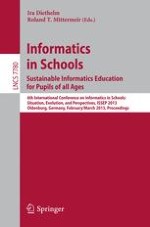2013 | Buch
Informatics in Schools. Sustainable Informatics Education for Pupils of all Ages
6th International Conference on Informatics in Schools: Situation, Evolution, and Perspectives, ISSEP 2013, Oldenburg, Germany, February 26–March 2, 2013. Proceedings
herausgegeben von: Ira Diethelm, Roland T. Mittermeir
Verlag: Springer Berlin Heidelberg
Buchreihe : Lecture Notes in Computer Science
